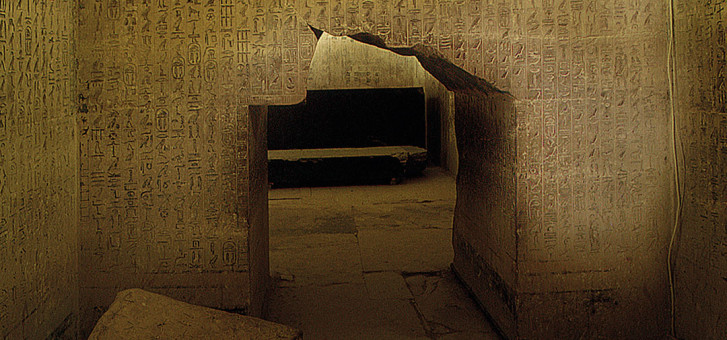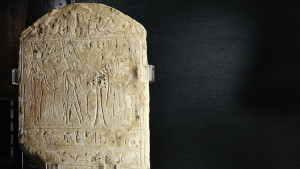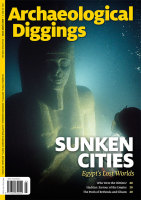In the 1988 movie Beetlejuice, the recently passed protagonists Barbara and Adam read from a book called “Handbook for the Recently Deceased” as their guide of what to expect in the afterlife. Although an important prop in the movie concept, the concept itself isn’t new. The ancient Egyptians took the idea seriously enough that they wrote books, spells, texts, even made a map of the afterlife showing the route to take and explanations of the realm and recorded it on tomb and temple walls, papyrus, mummy wrappings and directly to sarcophagi. These books were an evolving form of Egyptian funerary texts, guiding and protecting the deceased as he or she travelled through the afterlife and may have included the reciting of specific spells at certain hours of the night or at guarded doors to gain safe passage.
The earliest funerary writings are the Pyramid texts beginning in the Old Kingdom (2686–2181 bc) from the pharaoh Unas (also known as Wenis) of Dynasty V and were located in the pyramids of the rulers at Saqqara during this era. However by the end of the Old Kingdom, some non-royal tombs were being decorated with various sections of the pyramid texts as well. Their use was not limited to the Old Kingdom, as they were included in the pyramids of the three queens of Pepi II in Dynasty VI. The ruler of Dynasty VIII, Ibi, also had them included in his pyramid for the safe traversing of the celestial road to the afterlife. The use of pyramid texts was omitted during the Middle Kingdom (2040—1782 bc), as pyramids were not inscribed at this time. However in Dynasty XII of this era, the mastaba of Senwosret-Ankh included the account as found in Unas’s pyramid. Into the Late Period, spells of these texts can be found on sarcophagi and tombs.

The weighing of the heart ritual, from the famous chapter 125 of “The Book of the Dead.” This chapter lists the denials of wrongdoing, and illustrates the god Osiris, ruler of the dead, weighing the heart of the dead individual. The “Book of the Dead” is a contemporary term for about 200 compositions, which were assigned numbers in 1842 for reference purposes.
These carved incantations were separated by means of a vertical line and introduction, and have been classified into 228 “utterances” that are formed within three basic components—the reanimation of the deceased from death, the ascension to the sky and finally, acceptance as one with the gods. Coloured green to represent rebirth, the hieroglyphs were positioned in the antechamber, burial chamber and corridors. One of the wonderful aspects of hieroglyphs can be a tangible connotation even if you don’t understand the words. As the purpose of these spells was to ensure the protection and resurrection of the ruler and his ascent into the afterlife (in the sky), the use of key imagery is significant. The metaphors are clear—a ramp to the sky where clouds, tempest storms, the sun, birds, locusts and beetles aid transport all form part of the corpus of these incantations. A prominent god named was Shu, holding up the sky. It’s like the ancients were saying, “This is the way to the afterlife! Rise above and we will help you!”
Carved onto the sarcophagus chamber wall of the pharaoh Unas are the utterances describing Unas alighting to the sky to the sun god. It reads in part:
Re-Atum, this Unas comes to you,
A spirit indestructible
Who lays claim to the place of the four pillars!
Your son comes to you, this Unas comes to you,
May you cross the sky united in the dark,
May you rise in lightland, the place in which you shine!
Seth, Nephthys, go proclaim to Upper Egypt’s gods
And their spirits:
“This Unas comes, a spirit indestructible,
If he wishes you to die, you will die,
If he wishes you to live, you will live!”. . .
Re-Atum, your son comes to you,
Unas comes to you,
Raise him to you, hold him in your arms,
He is your son, of your body, forever!
(Lichtheim, M.,1975, pp.30–32)

Chapter 17 of the Book of the Dead, fresco, from the Tomb of Nefertari (QV66), chief royal wife of Ramesses II. From the left there are two lions with the symbol of Atum, the Bennu bird god, the mummy of Nefertari protected by two falcons, symbols of the goddesses Isis and Nephthys, and the genius of the Nile kneeling. Chapter 17, one of the longest individual compositions in the “Book of the Dead,” identifies the deceased individual with the creator-god and promises the formulae for elevation and transfiguration.
Coffin Texts progressed from the earlier pyramid texts and date to the Middle Kingdom and were mostly decorated on coffins, hence their name, but examples have been found on papyri, mummy masks, canopic chests and on tomb walls. They were designed for all deceased persons, not just royalty, and included the new concept of reunion with loved ones in the afterlife. Within these texts the perception of the afterlife became more tangible and its hazards more intense, indicating a developing, deeper thought process of the Egyptian mind. Transformation spells allowed the pharaoh to change into a bird soaring into the sky and the deceased into numerous gods such as air, fire, crocodile, child or grain. Spell 290, for example, relates this concept as
“. . . into every god into which one might desire to transform” (Hornung, E., 1999, p.9).
There are more than 1000 spells relating to the Coffin Texts and spell 162 relates to the “Four Winds.” In part its translation reads:
To gain control over the Four Winds of the sky:
By these maidens have I been given these winds.
North Wind is she who circulates about the Haunebut, stretches out her arms to the ends of the Two Lands, and subsides after she has brought her beloved’s needs each day. . . .
East Wind is she who opens the celestial window, releases the eastern breezes, and prepares a fair path for Re that he may ascend on it. . . .
West Wind is he, Ha’s brother and Iaau’s offspring, who lived as a single entity before duality existed in this world.
South Wind is he, South Wind as a Nubian of the South, who brings water and germinates life. . . .
Hail to you, you Four Winds of the sky, bulls of the sky! I tell [each of] you your name and the name of the one who has given them to you. I know your genesis. You came into being even before people were born and gods existed, before birds were snared and bulls lassoed, before the jaws of Matjeret, the great god’s daughter, were bound up and the wish of the Ancient one, lord of heaven and earth, was fulfilled . . . .” (Wente, E.F., 2003, pp.265, 266).
As part of the Coffin Texts a central inclusion is “The Book of the Two Ways,” outlining for the first time a map of the underworld and the safe journey through the duat for the deceased by recitation of certain spells. The reference to the Ways is the possible journeys by water or land routes from the eastern horizon at sunrise but it is fraught with danger and obstacles such as guardians, pitch-blackness and a “fiery court” placed around the sun.

Scene from “The Book of the Dead” in the Louvre Museum, Paris. The book contains a series of spells devised to generate the resurrection of the deceased while ensuring his safety in the afterlife. This text was developed from the Pyramid and Coffin Texts in the New Kingdom (1570–1070 bc), the Third Intermediate Period (1070–664 bc) and the Late Period (664–332 bc).
The Two Ways lead to the site known as Rosetau located at “the boundary of the sky” and where the corpse of Osiris lies. One of the goals is to reach the Field of Offerings, a place of plenty. However the ultimate goal of the deceased who makes this journey is to look upon the face of Osiris and in doing so cannot die.
A discourse from the sun god Re in the Coffin Texts enlightens the reader to four good deeds he did from the time of creation and two proclamations of significance. He explains that he made every man equal and that he is not responsible for the wrong of mankind; rather it is the individual who has free will. A section from spell 1130:
Words spoken by Him-whose-names-are-hidden, the All-Lord, as he speaks before those who silence the storm, in the sailing of the court.
Hail in peace! I repeat to you the good deeds which my own heart did for me from within the serpent-coil, in order to silence strife.
I did four good deeds within the portal of lightland:
I made the four winds, that every man might breathe in his time.
This is one of the deeds.
I made the great inundation, that the humble might benefit by it like the great. This is one of the deeds.
I made every man like his fellow; and I did not command that they do wrong. It is their hearts that disobey what I have said. This is one of the deeds.
I made that their hearts are not disposed to forget the West, in order that the sacred offerings be made to the gods of the nomes. This is one of the deeds.
I have created the gods from my sweat, and the people from the tears of my eye.
(Lichtheim, M., 1975, pp.131, 132)
The “Book of the Dead,” also known as “The Coming Forth by Day,” is a series of spells devised to generate the resurrection of the deceased while ensuring his safety in the afterlife. These spells developed from the Pyramid and Coffin Texts with new illustrated chapters dating from the New Kingdom (1570–1070 bc), including the Third Intermediate Period (1070–664 bc) and the Late Period (664–332 bc). As with the preceding Pyramid and Coffin Texts these series of spells were intended for the reciting and ritual enactments both during and after the burial. It was during the short interlude of the Amarna period under the rule of Akhenaten (1350–1334 bc) that the use of this book ceased. However the gilded coffin and several artefacts of Tutankhamun have chapters inscribed on them. The “Book of the Dead” was mass-produced on papyri with the name and titles of the deceased left blank ready for inclusion after purchase. The completed item could be either buried with the deceased, in a sarcophagus or alternatively in a container in the burial chamber.

“The Book of the Two Ways” Detail from the floor of the coffin of Gua, chief physician of Djehutyhotep and governor of Bersha. The paintings recall the “The Book of the Two Ways.” The two curved lines (top right corner) are its major feature and it is from these that the modern name “The Book of the Two Ways” is derived. The upper path is blue and called the “water way;” the lower is the black “land way.” The text that accompanies the scenes are spells to enable the deceased to sail with Re to pass certain doors and their demon keepers, then proceed on one or both of the ways to reach the goal of the afterlife with Osiris.
A highly significant and long chapter, spell 125, is known as “The Judgement of the Dead, the Declaration of Innocence” and contains a section referred to as the Negative Confession, a series of 35 lines of sins where the deceased states he has not committed them. The purpose behind this profound declaration recited at the Judgement scene where the deceased’s heart is weighed against a feather (maat), is to ensure that by having lived a good life without sin eternal life will ensue. The accompanying vignette shows the heart and a feather at equal weight on a scale supervised by the god Anubis. The crocodile-headed Ammit (some images show a dog’s head), a composite and fearful animal with a half lion, half hippopotamus body lies in wait ready to devour the heart should the deceased not be free from sin, and this image is a popular symbolic motif with papyrus sellers in Egypt to this day. Consideration has been given to this composite animal of land and water as a representation that the damned had nowhere to escape to. A selection from spell 125 is as follows:
I have not done crimes against people,
I have not mistreated cattle,
I have not sinned in the Place of Truth.
I have not known what should not be known,
I have not done any harm.
I did not begin a day by exacting more than my due,
My name did not reach the bark of the mighty ruler.
I have not blasphemed a god,
I have not robbed the poor.
(Lichtheim, M., 1976, p.125)
Books like “What Is In the Duat?” (the netherworld or underworld), also known as “Guides to the Hereafter,” were created in the New Kingdom as a set, perpetual collection of spells. These earlier books concerned themselves with the 12 hours of the night and the journey of the sun god. There are a number of books created in this era with such intriguing titles as the “Book of Gates,” “Caverns,” “Earth,” “Sky,” “Nut” and “Day and Night,” to name just a few. The last religious book relating to the afterlife in Egypt, the “Book of Traversing Eternity,” is preserved in surviving artefacts dating to the Roman Period, first and second centuries ad.





